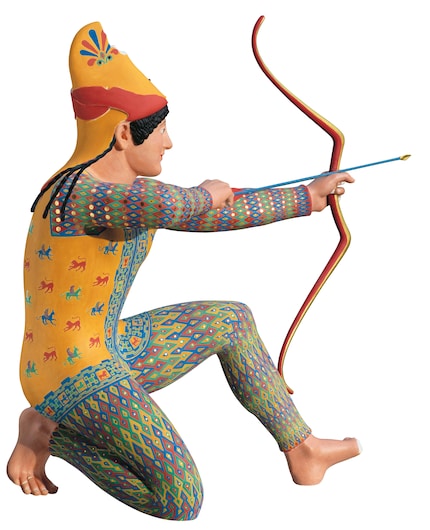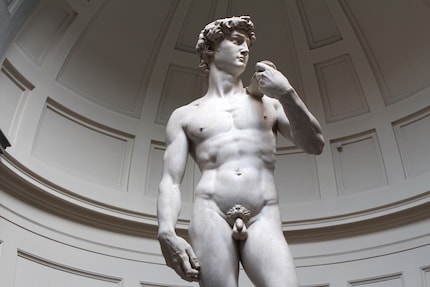

Say what? Roman statues weren’t actually white?
Smooth marble. Rock-hard six-pack. Small penis. Bright white. This is what most of us imagine when we hear «ancient statue». And most of it’s correct. The images of Greek and Roman youths were indeed carved from marble, fit and naked – but they were also colourful.
It’s long been proved that the Greeks and Romans painted their sculptured art masterpieces to be full of colour. And yet the myth of the white sculpture persists in many minds to this day. It did in mine, too. Until I recently clicked half-heartedly through the Arte media library. Having just watched Love is Blind on Netflix, I had a guilty conscience. Guilty, because instead feeding my brain, I’d been frittering away my time with mindless reality TV. I was counting on Arte to make me feel better.
In just four minutes, I learned that Greek sculptures were colourful. Very colourful, in fact. They had brown hair, red lips, yellow dresses with blue embellishments and gold earrings. Or colourful plaid pants that’d make any old hippie green with envy. A blue-white Greece? Nope!

Source: Liebighaus Skulpturensammlung, Norbert Miguletz
The enlighteners wanted to set themselves apart
According to the Skulpturenmuseum Liebighaus in Frankfurt, the Renaissance is to blame for today’s widespread belief in colourless ancient statues. In the 14th century, Italian scholars explicitly distinguished themselves from the Middle Ages through their moral concepts. All of a sudden, the ancient world was cool again. One sculpture after another was excavated in Rome. By then, time had probably left its mark, reverting them to an almost white. This came in handy for the enlighteners; the white statues, shapely and understated, were the opposite of the ostentatious and colourful church sculptures. No wonder, then, that sculptures such as Michelangelo’s David were created at the time.

People in the Renaissance also held on to this idea when the Laocoön group (now held in the Vatican) was excavated in 1503 and showed clear traces of paint. It was easier to talk yourself out of this fact or reinterpret it than to rethink your whole value system.
For a long time, the German archaeologist Johann Joachim Winckelmann was seen as a proponent of this «white antiquity». Especially because his work, History of Ancient Art, originally published in 1764, contains the sentence «… a beautiful body will, accordingly, be the more beautiful the whiter it is …» All the while, he was, in fact, admiring the colour traces on a sculpture of the goddess Artemis, which had been excavated in Pompeii in 1760. Pompeii was buried in AD 79 during the eruption of Mount Vesuvius. The volcanic ash preserved the colour pigments on the statue, making their existence undeniable.
Except, of course, to the great fascist dictators of the 20th century. Mussolini and Hitler regarded the white marble figures with their toned torsos as proof of the superiority of the Aryan race. (People truly will clutch at straws in an attempt to justify crude ideologies.)

Source: Shutterstock
Reconstructions have been possible for some years thanks to UV light
Since the 1980s, especially the Brinkmanns, a married archaeologist couple, have been credited with slowly making more and more people aware that the ancient times were not, in fact, white, but colourful. Based on examinations with UV light, the two archaeologists create colourful reconstructions of the since colourless sculptures. The results can be seen in the travelling exhibition Chroma: Ancient Sculpture in Color, currently at the Metropolitan Museum of Art in New York.
The fact that the myth of the white sculptures from antiquity has held up for so long relies on two aspects. First, an honest misjudgment, as the colour had long since faded from many of the sculptures that had been dug up. Second, explicit denial, because colourful art didn’t fit a given worldview.
Header image: Study on the colour of the Treu Head, Photo: Liebighaus Skulpturenmuseum
My life in a nutshell? On a quest to broaden my horizon. I love discovering and learning new skills and I see a chance to experience something new in everything – be it travelling, reading, cooking, movies or DIY.
Interesting facts about products, behind-the-scenes looks at manufacturers and deep-dives on interesting people.
Show all

